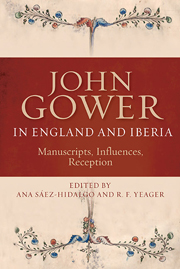Book contents
- Frontmatter
- Contents
- List of Illustrations
- Abbreviations
- Introduction
- I Manuscripts
- II Iberia
- 5 The English Literature of Nájera (1367) from Battlefield Dispatch to the Poets
- 6 At the Nájera Crossroads (1367): Anglo-Iberian Encounters in the Late Fourteenth Century
- 7 Spanish Literary Influence in England: John Gower and Pedro Alfonso
- 8 From Norwich to Lisbon: Factionalism, Personal Association, and Conveying the Confessio Amantis
- III The Classical Tradition
- IV Economy
- V Reception
- Notes on Contributors
- Bibliography
- Index
6 - At the Nájera Crossroads (1367): Anglo-Iberian Encounters in the Late Fourteenth Century
from II - Iberia
Published online by Cambridge University Press: 05 August 2014
- Frontmatter
- Contents
- List of Illustrations
- Abbreviations
- Introduction
- I Manuscripts
- II Iberia
- 5 The English Literature of Nájera (1367) from Battlefield Dispatch to the Poets
- 6 At the Nájera Crossroads (1367): Anglo-Iberian Encounters in the Late Fourteenth Century
- 7 Spanish Literary Influence in England: John Gower and Pedro Alfonso
- 8 From Norwich to Lisbon: Factionalism, Personal Association, and Conveying the Confessio Amantis
- III The Classical Tradition
- IV Economy
- V Reception
- Notes on Contributors
- Bibliography
- Index
Summary
Scholarship in Anglo-Iberian relations developed during the second half of the twentieth and first decade of the twenty-first century to such an extent that few readers would subscribe today to the often quoted statement made in 1906 by the eminent hispanophile James Fitzmaurice-Kelly about the “almost complete insulation of each country with regard to one another” in the Middle Ages, or his other affirmation that “the first step to sustained intellectual commerce” started at the end of the fifteenth century, in allusion to the thirteen Fables of Alfonce (by the Aragonese Jewish convert, Pedro Alfonso, or Petrus Alphonsus) which were included in the 1483 edition of Caxton's Aesop. María Bullón-Fernández, among others, has also drawn our attention to this fact. Two historians in the 1950s had indeed opened the ground for new views in relation to the fourteenth century: the Spanish medievalist Luis Suárez Fernández and the Oxford scholar Peter E. Russell, although in more recent years the current interest in Al-Andalus as a decisive factor in the conformation of Europe and European culture has yielded books such as those by Jeffrey Jerome Cohen, Simon R. Doubleday and David Coleman, Sharon Kinoshita, Lisa Lampert-Weissig, or, some decades earlier, one by Alice E. Lasater.
My purpose in this chapter is not to focus on this latter sort of exploration, but rather to look back again on the particular historical, political, and dynastic conditions that linked England to Iberia during the fourteenth century, a period when writers such as John Gower, Geoffrey Chaucer, and Canciller Pero López de Ayala lived and composed their best known works.
- Type
- Chapter
- Information
- John Gower in England and IberiaManuscripts, Influences, Reception, pp. 103 - 118Publisher: Boydell & BrewerPrint publication year: 2014



